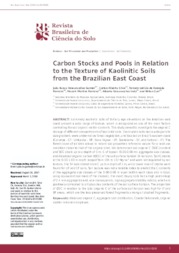Carbon stocks and pools in relation to the texture of kaolinitic soils from the Brazilian East Coast.
Carbon stocks and pools in relation to the texture of kaolinitic soils from the Brazilian East Coast.
Author(s): GOMES, J. B. V.; SILVA, C. A.; FERREIRA, T. L. de A.; FERREIRA, M. M.; INDA, A. V.; CURI, N.
Summary: Extremely kaolinitic soils of Tertiary age elevations on the Brazilian east coast present a wide range of texture, which is recognized as one of the main factors controlling the soil organic matter contents. This study aimed to investigate the organic C storage of different compartments of kaolinitic soils. The studied soils had a wide particle size gradient, were under native forest vegetation, and located on Brazil?s eastern coast (Coruripe - CF, Umbaúba - UF, Nova Viçosa - VF, Sooretama - SF, and Itaboraí - IF). The forest cover of all sites allows to record soil properties reference values for a land use condition closer to that of the original sites. We determined soil organic C (SOC) content and SOC stock up to a depth of 1 m, C of topsoil (0.00-0.08 m), aggregate size classes, and dissolved organic carbon (DOC) of the soil surface horizon (A horizon). Soil C stocks at the 0.00-1.00 m depth ranged from 105 to 137 Mg ha-1 and were not regulated by soil texture. The SF soils stored more C up to a depth of 1 m, while lower mean C stocks were found for UF and CF soils. Soil texture was not a reliable index to predict the C contents of the aggregate size classes of the 0.00-0.08 m layer (within each class and in total, using equivalent soil mass of the classes). The most clayey soils had a high percentage of 2-4 mm aggregates and, as a consequence, high aggregate stability indices, which are positively correlated to silt plus clay contents of the soil surface horizon. The proportion of DOC in relation to the total organic C of the surface soil horizon was high for IF and UF areas, which are the less preserved forest fragments among all studied fragments.
Publication year: 2018
Types of publication: Journal article
Unit: Embrapa Forestry
Observation
Some of Embrapa's publications are published as ePub files. To read them, use or download one of the following free software options to your computer or mobile device. Android: Google Play Books; IOS: iBooks; Windows and Linux: Calibre.
Access other publications
Access the Agricultural Research Database (BDPA) to consult Embrapa's full library collection and records.
Visit Embrapa Bookstore to purchase books and other publications sold by Embrapa.

